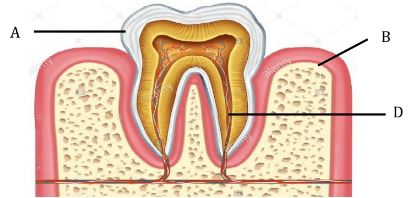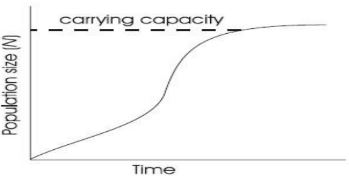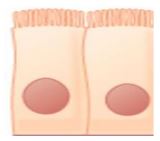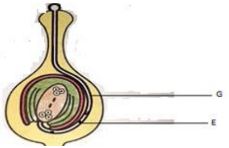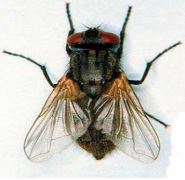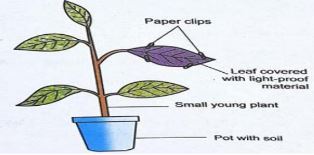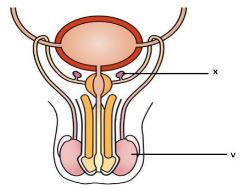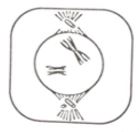BIOLOGY
PAPER 1
THEORY
INSTRUCTIONS TO CANDIDATES
- Answer ALL the questions.
- Answers must be written in the spaces provided in the question paper.
- Additional pages must not be inserted.

Questions
- How does growth as a characteristic of living organisms differ in plants and animals ? (2marks)
-
- State the role of active transport in animal nutrition (1mark)
- Cyanide lowers the rate of active transport. Explain? (2marks)
- The figure below is a diagram of a vertical section of a mammalian tooth.
- Name the part labelled A and B. (2 marks)
A
C - State two ways in which structure D is adapted to its functions. (2 marks)
- List two ways of preventing gingivitis. (2 marks)
- Name the part labelled A and B. (2 marks)
- The figure below shows % saturation of oxygen in blood in fish as water passes along the gill plate.
-
- Name the type of blood flow shown in the gill plate. (1mark)
- Explain the advantage of the type of flow named in a (i) above (2marks)
- State two organs in humans which display the type of flow named in a (i) above (2marks)
- State two ways in which floating leaves of aquatic plants are adapted to gaseous exchange (2marks)
-
- The equation below shows an oxidation reaction of food substances.
C51H98O6 + 145O2 → X CO2 + 98 H2O + energy- What do you understand by the term respiratory quotient? (1mark)
- Determine respiratory quotient of the oxidation of food substance. (2marks)
- Identify the food substances. (1mark)
- When any one of the growth parameters such as growth in size or weight, increase in number of cells are plotted in a graph against time like below, a clear curve is obtained
State its name(1mark) - The graph below represents the growth in a certain phylum.
How does this differ from growth in humans? (1mark) - The embryo of a dry, fully developed seed usually passes through a period of rest after ripening period and it cannot germinate even when provided with all favorable conditions. State the significance of this. (2marks)
-
- Cowpeas seeds were place in a vacuum flask and left for five days. What is the expected change in composition of gases in the flask on the sixth day? (1mark)
- Give a reason for your answer in (a) above (1mark)
- Biotechnologist works day a night to curb food insecurity using the knowledge of polyploidy in genetics.
- Explain the economic importance of such practice? (2marks)
- Define a backcross? (1 mark)
- The structure below was obtained from an animal cell
- What is the name of the hair like processes and state its function? (2marks)
Name
Function - From which parts of the mammalian body are these structures found? (1mark)
- State the effect of cigarette smoking to the structure? (1mark)
- What is the name of the hair like processes and state its function? (2marks)
- A student was found to have blood group B+
- What type of antibody is present in his plasma? (1mark)
- Which antigens are present in this blood group? (1mark)
- Plants relatively have less waste to excrete than animals. Give two reasons to explain this observation (2marks)
- State two methods by which plants get rid of their waste products (2marks)
- To estimate the population size of mosquitoes in Banji village that covers an area of 25km2, visiting researchers caught 400 mosquitoes which they marked and released. After 24 hours, 200 mosquitoes were caught out of which 120 had not been marked.
- Suggest the sampling method described above. (1 mark)
- What are the disadvantages of this method? (2 marks)
- The table below shows stomatal distribution on leaves A and B and their surface area. Use the information to answer the questions.
Leaf surface A B Numer of
StomataUpper leaf
surface20 5 Lower leaf
surface0 15 Surface
area25cm2 18cm2
Identify with reasons the habitats of the plant from which the leaves were obtained.
Leaf A:(2 marks)
Habitat
Reason
Leaf B: (2 marks)
Habitat
Reason - Name the causative agent of the following diseases (2 marks)
- Trichomoniasis.
- Gonorrhea
- The diagram below shows a pollen tube as it develops down the style. Use it to answer the questions that follows;
- Name the part labelled G. (1 mark)
- State two functions of structure labelled E. (2 marks)
-
- Define parthenogenesis? (1 mark)
- Name the plant hormone that induces fruit ripening. (1 mark)
- A group of Form Three students collected a certain specimen for study as shown below. Study it carefully and use it to answer the questions that follow.
- Name the type of metamorphosis in the above specimen. (1 mark)
- Give any two advantages of the above metamorphosis. (2 marks)
-
- Give two structural features in a leaf that adapts it to absorb Carbon (IV) Oxide. (2 marks)
- Name the cell organelle in which Carbon (IV) oxide combines with water to form a complex organic compound takes place (1 mark)
- In an experiment to investigate a factor affecting photosynthesis; leaf of a potted plant, which had been kept in the dark overnight was covered with an aluminum foil as shown in the diagram below. The set up was kept in the sunlight for three hours after which a food test was carried out on the leaf.
- Which factor was being investigated in the experiment? (1 mark)
- Which food test was carried out? (1 mark)
- State the results of the food test. (1 mark)
- Explain how the following plant adaptations minimizes rate of transpiration (2marks)
- Sunken stomata
- Thick cuticle
- Explain how drooping of leaves on a hot sunny day is advantageous to a plant (2marks)
- Name two tissues in plants which are thickened with lignin (2marks)
- The diagram below shows the front view of a male reproductive system.
- Give the functions of the structures labelled X and V (2marks)
X
V - What is the role of Follicle Stimulating Hormone in male reproduction? (1mark)
- Give the functions of the structures labelled X and V (2marks)
- Explain why the concentration of insecticides in fish eating birds may be hundreds of times greater than its concentration in the water where the fish live (3marks)
- The diagram below shows a stage in meiosis
State the biological significance of the stage represented on the diagram above (1mark) - How do the following factors hinder self-pollination in flowering plants? (3marks)
- Self-sterility
- Heterostyly
- Protogyny

Marking Scheme
- How does growth as a characteristic of living organisms differ in plants and animals?(2marks
- In plants growth occurs at meristematic tissues only ;while in animals growth occurs all over the body ;
- In plants growth occurs at meristematic tissues only ;while in animals growth occurs all over the body ;
-
- State the role of active transport in animal nutrition (1mark)
- Reabsorbtion of sugars and some salts in the kidney
- Absorption of digested food from the alimentary canal into the blood stream.
- Excretion of waste products from body cells.
- Cyanide lowers the rate of active transport. Explain? (2marks)
- cyanide is an enzyme inhibitor, it affects the rate of active transport
- cyanide is an enzyme inhibitor, it affects the rate of active transport
- State the role of active transport in animal nutrition (1mark)
- The figure below is a diagram of a vertical section of a mammalian tooth.
- Name the part labelled A and B. (2 marks)
- Enamel
- Gum
- State two ways in which structure D is adapted to its functions. (2 marks)
- Contains blood vessels which supplies food nutrients and oxygen and remove carbon IV oxide and nitrogenous waste products;
- Contains nerve endings for sensitivity;
- List two ways of preventing gingivitis. (2 marks)
- Regular brushing of teeth;
- Proper exercise of the teeth by eating tough fibrous food;
- Eating foods that are rich in vitamin C
- Name the part labelled A and B. (2 marks)
- The figure below shows % saturation of oxygen in blood in fish as water passes along the gill plate.
- Name the type of blood flow shown in the gill plate. (1mark)
- Counter current flow
- Counter current flow
- Explain the advantage of the type of flow named in a (i) above (2marks)
- Creates a steep diffusion gradient; that enhances the rate of gaseous exchange across the gill filaments/ increases rate of gaseous exchange; through diffusion (Rej increases rate of gaseous exchange/enhances gaseous exchange alone
- Creates a steep diffusion gradient; that enhances the rate of gaseous exchange across the gill filaments/ increases rate of gaseous exchange; through diffusion (Rej increases rate of gaseous exchange/enhances gaseous exchange alone
- State two organs in humans which display the type of flow named in a (i) above
- Kidney; Placenta; Ileum (2marks)
- Kidney; Placenta; Ileum (2marks)
- State two ways in which floating leaves of aquatic plants are adapted to gaseous exchange (2marks)
- Stomata found only on upper epidermis to allow efficient gaseous exchange;
- Presence of large air-spaces/aerechyma tissue to enable floating and storage of air;
- Lack cuticle to enhance gaseous exchange;
- Name the type of blood flow shown in the gill plate. (1mark)
- The equation below shows an oxidation reaction of food substances.
C51H98O6 + 145O2 → X CO2 + 98 H2O + energy- What do you understand by the term respiratory quotient? (1mark)
- Volumetric relationship between Carbon (IV) oxide produced and oxygen consumed
- Volumetric relationship between Carbon (IV) oxide produced and oxygen consumed
- Determine respiratory quotient of the oxidation of food substance. (2marks)
- R.Q = CO2 produced
O2 used up
R.Q = 102/145
R.Q = 0.7
- R.Q = CO2 produced
- Identify the food substances. (1mark)
- Fat/ Lipid
- Fat/ Lipid
- What do you understand by the term respiratory quotient? (1mark)
- When any one of the growth parameters such as growth in size or weight, increase in number of cells are plotted in a graph against time like below, a clear curve is obtained
State its name- sigmoid curve (1mark)
- sigmoid curve (1mark)
- The graph below represents the growth in a certain phylum.
How does this differ from growth in humans? (1mark)- In humans it’s continuous from time of birth to maturity when it slightly tails off while for this phylum it’s discontinuous /in intervals with shedding of exoskeleton
- In humans it’s continuous from time of birth to maturity when it slightly tails off while for this phylum it’s discontinuous /in intervals with shedding of exoskeleton
- The embryo of a dry, fully developed seed usually passes through a period of rest after ripening period and it cannot germinate even when provided with all favorable conditions. State the significance of this. (2marks)
- Provides the seeds with enough time for dispersal so that they can germinate in suitable environment
- Enables seeds to survive during adverse seeds to survive during adverse environmental conditions
- The embryo has time to develop until favourable conditions are available
-
- Cowpeas seeds were place in a vacuum flask and left for five days. What is the expected change in composition of gases in the flask on the sixth day? (1mark)
- Decrease in oxygen and increase in carbon(iv)oxide
- Decrease in oxygen and increase in carbon(iv)oxide
- Give a reason for your answer in (a) above (1mark)
- Germinating seeds respire using oxygen and release carbon(IV)oxide
- Germinating seeds respire using oxygen and release carbon(IV)oxide
- Cowpeas seeds were place in a vacuum flask and left for five days. What is the expected change in composition of gases in the flask on the sixth day? (1mark)
- Biotechnologist works day a night to curb food insecurity using the knowledge of polyploidy in genetics.
- Explain the economic importance of such practice? (2marks)
- Increases yields in plants
- Cause early maturity in plants
- Enhance resistance to pest, disease and drought
- Define a backcross? (1 mark)
- A cross between an offspring with one of its parents
- A cross between an offspring with one of its parents
- Explain the economic importance of such practice? (2marks)
- The structure below was obtained from an animal cell
- What is the name of the hair like processes and state its function? (2marks)
- Name -Cilia
- Function- Propel mucus or a fertilised ovum
- From which parts of the mammalian body are these structures found? (1mark)
- Trachea and oviduct
- Trachea and oviduct
- State the effect of cigarette smoking to the structure? (1mark)
- Cigarettes contain tar which impairs/inhibit the action of cilia in the respiratory tract leading to cancer.
- Cigarettes contain tar which impairs/inhibit the action of cilia in the respiratory tract leading to cancer.
- What is the name of the hair like processes and state its function? (2marks)
- A student was found to have blood group B+
- What type of antibody is present in his plasma? (1mark)
- a
- a
- Which antigens are present in this blood group? (1mark)
- B and Rhesus antigens
- B and Rhesus antigens
- What type of antibody is present in his plasma? (1mark)
- Plants relatively have less waste to excrete than animals. Give two reasons to explain this observation (2marks)
- Plants reuse some of their waste products;
- Plants produce their waste products slowly compared to animals that produce slowly ;
- State two methods by which plants get rid of their waste products (2marks)
- Diffusion
- Transpiration
- Guttation
- Exudation
- Deposition ( any two)
- To estimate the population size of mosquitoes in Banji village that covers an area of 25km2 ,visiting researchers caught 400 mosquitoes which they marked and released. After 24 hours, 200 mosquitoes were caught out of which 120 had not been marked.
- Suggest the sampling method described above. (1 mark)
- Capture recapture method
- Capture recapture method
- What are the disadvantages of this method? (2 marks)
- Some organism may die during the study period;
- The mark may come the out during the study period;
- Suggest the sampling method described above. (1 mark)
- The table below shows stomatal distribution on leaves A and B and their surface area. Use the information to answer the questions.
Identify with reasons the habitats of the plant from which the leaves were obtained.- Leaf A: Habitat Fresh water; (1 mark)
- Reason; Maximum number of stomata on the upper leaf surface for quick loss of excess water by transpiration; (1 mark)
- Leaf B: Habitat: Savannah/ Rain forest; (1 mark)
- Reason : More stomata on lower surface than on the upper to reduce the surface area exposed to excessive loss of water by transpiration (1 mark)
- Name the causative agent of the following diseases (2 marks)
- Trichomoniasis.
- Trichomonas vaginalis
- Gonorrhea
- Neisseria gonorrhoea
- Neisseria gonorrhoea
- Trichomoniasis.
- The diagram below shows a pollen tube as it develops down the style. Use it to answer the questions that follows;
- Name the part labelled G. (1 mark)
- Pollen tube;
- Pollen tube;
- State two functions of structure labelled E. (2 marks)
- Fuse with the egg cell nucleus to form zygote
- Fuse with polar nuclei to form a triploid endosperm nucleus;
- Name the part labelled G. (1 mark)
-
- Define parthenogenesis? (1 mark)
- A type of asexual reproduction in insects where eggs produced without being fertilized are Bable to hatch into adult insects;
- A type of asexual reproduction in insects where eggs produced without being fertilized are Bable to hatch into adult insects;
- Name the plant hormone that induces fruit ripening. (1 mark)
- Ethylene;
- Ethylene;
- Define parthenogenesis? (1 mark)
- A group of Form Three students collected a certain specimen for study as shown below.
Study it carefully and use it to answer the questions that follow.- Name the type of metamorphosis in the above specimen. (1 mark)
- Complete metarmophosis;
- Complete metarmophosis;
- Give any two advantages of the above metamorphosis. (2 marks)
- Each stage occupies a different ecological niche; hence there’s no competition for resources e.g food;
- Each stage occupies a different ecological niche; hence there’s no competition for resources e.g food;
- Name the type of metamorphosis in the above specimen. (1 mark)
-
- Give two structural features in a leaf that adapts it to absorb Carbon (IV)
- Oxide. Broad lamina;, Many stomata
- Oxide. Broad lamina;, Many stomata
- Name the cell organelle in which Carbon (IV) oxide combines with water to form a complex organic compound takes place (1 mark)
- Chloroplast
- Chloroplast
- Give two structural features in a leaf that adapts it to absorb Carbon (IV)
- In an experiment to investigate a factor affecting photosynthesis; leaf of a potted plant, which had been kept in the dark overnight was covered with an aluminum foil as shown in the diagram below. The set up was kept in the sunlight for three hours after which a food test was carried out on the leaf.
- Which factor was being investigated in the experiment? (1 mark)
- Light;
- Which food test was carried out? (1 mark)
- Starch test;
- State the results of the food test. (1 mark)
- Starch absent/Iodine retains its brown colour/starch test negative;
- Starch absent/Iodine retains its brown colour/starch test negative;
- Which factor was being investigated in the experiment? (1 mark)
- Explain how the following plant adaptations minimizes rate of transpiration (2marks)
- Sunken stomata
- Water vapour accumulates in the pits reducing water vapour diffusion gradient hence reduced transpiration rate;
- Water vapour accumulates in the pits reducing water vapour diffusion gradient hence reduced transpiration rate;
- Thick cuticle
- Reduces permeability of the leaf to water thus reducing water loss;
- Reduces permeability of the leaf to water thus reducing water loss;
- Sunken stomata
- Explain how drooping of leaves on a hot sunny day is advantageous to a plant (2marks)
- The leaves expose a smaller surface area to the sun thus reducing excessive water;
- The leaves expose a smaller surface area to the sun thus reducing excessive water;
- Name two tissues in plants which are thickened with lignin (2marks)
- Parenchyma cells;
- Xylem vessels;
- The diagram below shows the front view of a male reproductive system.
- Give the functions of the structures labelled X and V (2marks)
- X. Provide an alkaline fluid which contains nutrients for the spermatozoa;
- V. Seminiferous tubules which provides a large surface area for production of sperms;
- What is the role of Follicle Stimulating Hormone in male reproduction? (1mark)
- Stimulates the synthesis and maturation of sperms;
- Stimulates the synthesis and maturation of sperms;
- Give the functions of the structures labelled X and V (2marks)
- Explain why the concentration of insecticides in fish eating birds may be hundreds of times greater than its concentration in the water where the fish live (3marks)
- Aquatic plants in water absorb the pesticides that drain into water bodies and so accumulate ,fish consume small quantities every time the ingest the water this also accumulates in the fish with time, as the birds continue feeding the contaminated fish they pesticides increase in levels
- Aquatic plants in water absorb the pesticides that drain into water bodies and so accumulate ,fish consume small quantities every time the ingest the water this also accumulates in the fish with time, as the birds continue feeding the contaminated fish they pesticides increase in levels
- The diagram below shows a stage in meiosis
State the biological significance of the stage represented on the diagram above (1mark)- The exchange of DNA hence increases genetic variation;
- The exchange of DNA hence increases genetic variation;
- How do the following factors hinder self-pollination in flowering plants? (3marks)
- Self-sterility
- It is a condition where pollen grains from the anthers cannot grow on the stigma of the same flower of plant/ are incompatible to stigma of the same plant/flower;
- Heterostyly
- Is a condition of having different arrangements of style and stigma i.e. shorter stamen than pistil;
- Protogyny
- it’s a condition where the female matures an its ready to receive the pollen grains before the male parts mature;
- Self-sterility
Download Biology Paper 1 Questions and Answers - Royal Exam Series Post Mock Trial Exams 2022.
Tap Here to Download for 50/-
Get on WhatsApp for 50/-
Why download?
- ✔ To read offline at any time.
- ✔ To Print at your convenience
- ✔ Share Easily with Friends / Students

